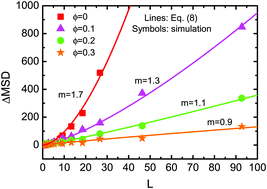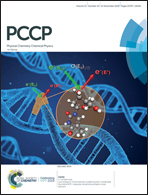Activity–crowding coupling effect on the diffusion dynamics of a self-propelled particle in polymer solutions
Abstract
The anomalous diffusion dynamics of an active particle in polymer solutions is studied based on a Langevin Brownian dynamics simulation. Firstly, the mean-square displacement (MSD) is investigated under various system parameters of active force Fa, probe size σa, polymer volume fraction ϕ and polymer chain length N. A very novel transition between superdiffusion and subdiffusion is observed with varying Fa and ϕ, owing to the activity and crowding competition effect. The two anomalous diffusion regimes are identified in the parameter space diagram. The increment of the MSD under activity is examined on intermediate time scales, which manifests a power law relation with the particle's dynamical persistence length L, i.e., ΔMSD = 2Lm, where the exponent m decreases with ϕ. Secondly, we explicitly evaluate the long-time diffusion coefficients D0a in a pure solvent and Da in polymer solutions. The dependence of relative diffusivity Da/D0a on volume fraction ϕ reproduces the well-known Phillies' equation exp(−κϕμ). The fitting parameters show μ ≃ 1, but κ apparently increases with activity. More importantly, our simulation justifies a multi-length scaling relation in a very similar form to that for passive probes, depending on simple structural parameters of the probe–polymer system. With the aid of an activation energy model, we find a counterintuitive activity–crowding coupling effect: activity enhances the effective viscosity experienced by the probe and thus strengthens the crowding-induced slowing of diffusion.



 Please wait while we load your content...
Please wait while we load your content...